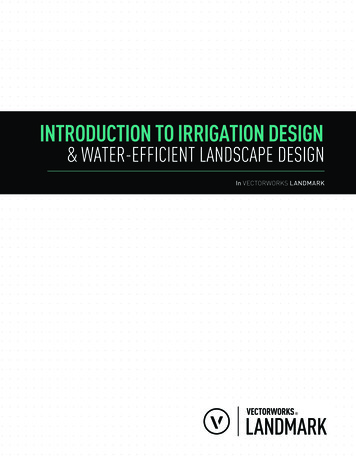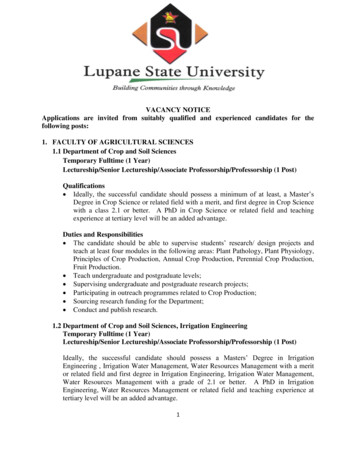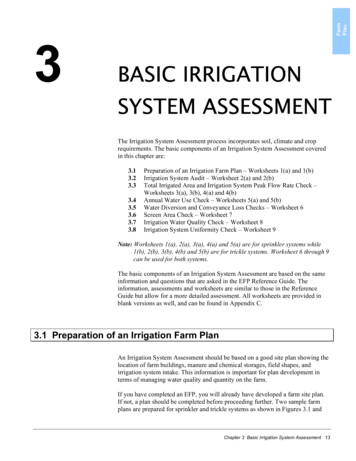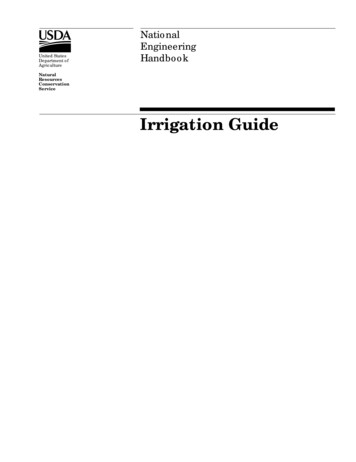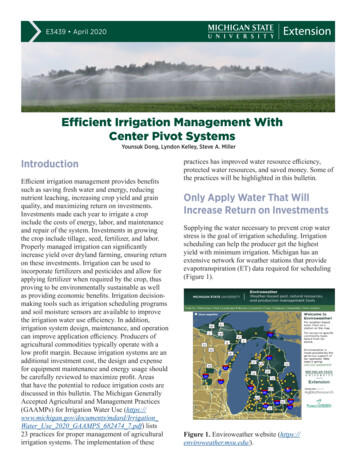
Transcription
UnitedChapterStates2Department ofAgricultureSoilConservationServiceChapter 2Part 623NationalEngineeringHandbookIrrigation Water RequirementsPart 623National Engineering HandbookIrrigation WaterRequirementsUse bookmarks and buttons to navigate document(210-vi-NEH, September 1993)2–1
Chapter 2Irrigation Water RequirementsPart 623National Engineering HandbookIssued September 1993The United States Department of Agriculture (USDA) prohibits discrimination in its programs on the basis of race, color, national origin, sex, religion,age, disability, political beliefs, and marital or familial status. (Not all prohibited bases apply to all programs.) Persons with disabilities who requirealternative means for communication of program information (braille, largeprint, audiotape, etc.) should contact the USDA Office of Communicationsat (202) 720-5881 (voice) or (202) 720-7808 (TDD).To file a complaint, write the Secretary of Agriculture, U.S. Department ofAgriculture, Washington, DC 20250, or call (202) 720-7327 (voice) or (202)720-1127 (TDD). USDA is an equal employment opportunity employer.2–2(210-vi-NEH, September 1993)
Chapter 2Irrigation Water RequirementsPrefacePart 623National Engineering HandbookIrrigation is vital to produce acceptable quality and yield of crops on aridclimate croplands. Supplemental irrigation is also vital to produce acceptablequality and yield of crops on croplands in semi-arid and subhumid climatesduring seasonal droughty periods. The complete management of irrigationwater by the user is a necessary activity in our existence as a society. Competition for a limited water supply for other uses by the public require the irrigation water user to provide much closer control than ever before. The importance of irrigated crops is extremely vital to the public's subsistence.Todays management of irrigation water requires using the best estimatethat current technology can provide for the determination of crop water useand field irrigation water requirements. Support for many of the estimatedvalues included in this chapter come from field research and many fieldevaluations over many years. Field evaluations and ground truthing mustalways be used to further refine the estimates used for planning irrigationsystems. This chapter of the SCS National Engineering Handbook (NEH)provides that current technology. It provides nationwide acceptable procedures to determine crop water needs. The specific procedure or equationused depends on the availability of specific climatic data needed for thatprocess and the desirable intensity level of managing irrigation water.Chapter 2 describes the processes that affect water use requirements for acrop, field, farm, group of farms, or project level evaluation. The processesinclude evaluation of crop water use, climatic relationship and data, reference crop evapotranspiration, crop coefficients, leaching requirements forsalinity control, temperature control and other auxiliary water requirements, effective precipitation, water table contribution, irrigation efficiencies, on-farm irrigation requirements, and project irrigation requirements.This chapter provides the processes for determining irrigation water requirements for state and local irrigation guides.Chapter 2 of Part 623 is a new chapter to the family of chapters currently inNEH Section 15, Irrigation. It is written for employees of the Soil Conservation Service who provide technical assistance to the water user with concerns for both water quantity and water quality. Other technical personnelfrom Federal, State, private, and local agencies will also find the chaptervery useful as a basic reference when providing technical assistance relating to irrigation water requirements.Other chapters in NEH section 15 describe Soil-plant relationships and soil water properties that affect movement, retention, and release of water in soil Planning farm irrigation systems Measurement of irrigation water Design of pumping plants Design criteria and design procedures for surface, sprinkler, andmicro irrigation methods and the variety of systems for each methodthat can be adaptable to meet local crop, water, and site conditionsand irrigation concernsThese chapters will come under the new Part 623, Irrigation, in the NationalEngineering Handbook series.(210-vi-NEH, September 1993)2–i
Chapter 2Irrigation Water RequirementsAcknowledgmentsPart 623National Engineering HandbookChapter 2 is an addition to the National Engineering Handbook, Part 623(currently known as Section 15, Irrigation). It was prepared by Dr. DerrelL. Martin, University of Nebraska at Lincoln, and Dr. James R. Gilley,Iowa State University at Ames, under contract to the Soil ConservationService (SCS). It has been several years in the development and reviewprocess. Valuable technical input was also provided by Otto W. Baumer,research soil scientist, National Soils Laboratory, SCS, Lincoln, NE. Principal SCS staff who contributed to the development and review of this publication were:Gylan L. Dickey (retired), Nelton O. Salch (retired), Carroll A.Hackbart (retired), Paul K. Koluvek (retired), Leland A. Hardy, LarryJ. Dawson, and Elwin A. Ross (retired), all irrigation engineers from theSCS National Technical Centers (NTC)Swayne F. Scott (retired) and Richard Van Klaveren (head, WNTCEngineering Staff), both former national irrigation engineer, SCS Engineering Division, Washington, DCWilliam J. Carmack, national water management engineer; Ronald L.Marlow, water management engineer; and Chuck Lander, agronomist,Washington, DCKendall L. Pfeiffer, West NTC; Floyd Bailey, Boise, ID; Carl Pachek,Pheonix, AZ; and Jerry Lemunyon, South NTC, Ft Worth., TX.Technical adequacy review from outside SCS was provided by Robert G.Evans, agricultural engineer, Washington State University at Prosser, forinput on the Frost Protection discussion; and Dale F. Heermann, Ft.Collins, CO, James L. Wright, Kimberly, ID, Terry A. Howell, Bushland,TX, David L. Carter, Kimberly, ID, and James D. Rhoades, Riverside, CA,all research scientists for the USDA, Agricultural Research Service. Editingand publication production assistance were provided by the TechnicalPublishing Team, SCS National Cartography and GIS Center, Fort Worth,TX. Final detail technical review was provided by Elwin A. Ross, irrigationengineer, SCS, Engineering Division, Washington, DC.2–ii(210-vi-NEH, September 1993)
Chapter 2Irrigation Water RequirementsChapter 2Contents:Part 623National Engineering HandbookIrrigation WaterRequirements623.0200Water requirements2–1(a) Introduction . 2–1(b) Irrigation requirements . 2–1623.0201Crop water use2–4(a) Introduction . 2–4(b) Evapotranspiration processes . 2–4(c) Direct measurement of evapotranspiration . 2–8(d) Estimating crop evapotranspiration . 2–11623.0202Climatic relationships and data2–13(a) Introduction . 2–13(b) Barometric pressure . 2–13(c) Air properties . 2–14(d) Wind relationships . 2–18(e) Estimating net radiation . 2–22(f) Estimating solar radiation . 2–32(g) Soil heat flux . 2–34(h) Weather stations . 2–37623.0203Reference crop evapotranspiration2–41(a) Selection and application of reference crop ET method . 2–41(b) Penman-Monteith method . 2–43(c) Radiation method . 2–52(d) Temperature method . 2–56(e) Evaporation pan method . 2–62(f) Summary . 2–65623.0204Crop coefficients2–66(a) Fundamental concepts . 2–66(b) Determining basal crop coefficients . 2–69(c) Water stress factor . 2–82(d) Wet soil evaporation . 2–85(e) Average crop coefficients . 2–88(f) Estimating evaporation during the nongrowing season . 2–91(g) Adjusting crop coefficients for real-time predictions . 2–92(h) Sensing ground cover . 2–97(i) Summary . 2–97(210-vi-NEH, September 1993)2–iii7–i
Chapter 2Irrigation Water Requirements623.0205Part 623National Engineering HandbookLeaching requirements for salinity control2–98(a) Significance of salinity . 2–98(b) Water quality evaluation . 2–99(c) Crop salt tolerance . 2–104(d) Leaching for salinity control . 2–115(e) Salinity management alternatives . 2–125(f) Reclamation of salt-affected soils . 2–129623.0206Auxiliary irrigation water requirements2–133(a) Frost protection . 2–133(b) Crop and soil cooling . 2–137(c) Wind erosion control . 2–138(d) Chemigation . 2–139(e) Plant disease control . 2–140(f) Seed germination . 2–141623.0207Effective precipitation2–142(a) Introduction . 2–142(b) Definition of effective precipitation . 2–142(c) Processes controlling effective precipitation . 2–142(d) Factors affecting effective precipitation . 2–144(e) Estimating effective precipitation . 2–146(f) Carryover soil moisture . 2–154623.0208Water table contribution2–155(a) Introduction . 2–155(b) Steady upward flow . 2–158(c) Hydraulic properties of soil . 2–162623.0209Irrigation efficiencies2–164(a) Introduction . 2–164(b) Irrigation efficiency (Ei) . 2–164(c) Uniformity of application . 2–167(d) Application efficiency (Ea) . 2–168(e) Irrigation adequacy . 2–170(f) Conveyance efficiency (Ec) . 2–181623.0210Onfarm irrigation requirements2–187(a) Net seasonal irrigation requirements . 2–187(b) System capacity requirements . 2–194(c) Net system capacity . 2–197(d) Irrigation scheduling . 2–2092–iv7–ii(210-vi-NEH, September 1993)
Chapter 2Irrigation Water Requirements623.0211Part 623National Engineering HandbookProject water requirements2–216(a) Introduction . 2–216(b) Irrigation project requirements . 2–216(c) Onfarm delivery schedules . 2–223(d) Water conservation . 2–225TablesAppendix ABlaney-Criddle Formula (SCS TR–21)2–227Appendix BDay of Year bols2–275Index2–281Table 2–1Locations of procedures to estimate irrigation2–3water requirementsTable 2–2Albedo for natural surfacesTable 2–3Average daily value of climatic parameters for an2–62–13example site near Dodge City, KansasTable 2–4Ratio of wind speeds based on measurement heights2–19Table 2–5Daytime wind speed2–21Table 2–6Clear sky radiation at sea level for various latitudes2–26and datesTable 2–7Clear sky radiation correction term for elevation2–27Table 2–8Values of the al parameter and the atmospheric2–30emittanceTable 2–9Emittance of longwave radiation by a perfect black body 2–31Table 2–10Extraterrestrial radiation(210-vi-NEH, September 1993)2–332–v
Chapter 2Irrigation Water RequirementsTable 2–11Part 623National Engineering HandbookSelected air properties for varying temperatures2–45and elevationsTable 2–12Aerodynamic resistancefor various wind speeds2–47and common configurations of weather stationsTable 2–13Adjustment factor br for the radiation method2–54Table 2–14Value of parameters used with the radiation method2–55Table 2–15Values of adjustment factor at for use in equation 2–502–58Table 2–16Values of adjustment factor bn for use in equation 2–512–59Table 2–17Values of adjustment factor bu for use in equation 2–512–60Table 2–18Daily percent of annual daytime hours2–61Table 2–19Pan coefficients for Class A evaporation pans2–63for different ground cover and levels of meanrelative humidity and 24-hour wind runTable 2–20Basal crop coefficient parameters for field and2–73vegetable crops for a grass reference cropTable 2–21Basal crop coefficients for alfalfa, clover, grass-2–77legumes, and pastures using a grass reference cropTable 2–22Basal crop coefficients for citrus grown2–78in predominantly dry areas with moderate windusing a grass reference cropTable 2–23Basal crop coefficient for full grown deciduous fruit2–79and nut trees using a grass reference cropTable 2–24Basal crop coefficients for sugarcane using a grass2–80reference cropTable 2–25Basal crop coefficients for grapes with clean cultivation, 2–80infrequent irrigation, and dry soil surface mostof the season using a grass reference cropTable 2–26Crop coefficients for paddy rice grown in the2–81United States mainland using a grass reference cropTable 2–27Monthly crop coefficients for some perennial cropsraised in Northwestern United States2–vi(210-vi-NEH, September 1993)2–81
Chapter 2Irrigation Water RequirementsTable 2–28Part 623National Engineering HandbookFraction of the soil surface wetted for various types2–85of irrigationTable 2–29Wet soil surface evaporation decay function f(t)2–86and the persistence factor Pf for typical soilsTable 2–30Average wet soil evaporation factor2–88Table 2–31Hanway’s stages of growth for corn2–93Table 2–32Irrigation water quality guidelines2–100Table 2–33Determinations normally required to evaluate2–101irrigation water quality problemsTable 2–34Salt tolerance of selected crops2–106Table 2–35Chloride tolerance limits of some fruit crop cultivars2–111and rootstocksTable 2–36Relative tolerance of selected crops to foliar injury2–112from saline water applied by sprinklersTable 2–37Boron tolerance limits for agricultural crops2–113Table 2–38Citrus and stone fruit rootstocks ranked in order2–114of increasing boron accumulation and transportto leavesTable 2–39Estimates of the electrical conductivity of drainage2–116water for determination of the leaching requirementsTable 2–40Sprinkling rate necessary for frost protection2–135Table 2–41Temperatures to start and stop overtree frost protection2–135Table 2–42Factors influencing effective precipitation2–144Table 2–43Average monthly effective precipitation as related2–148to mean monthly precipitation and average monthlycrop evapotranspirationTable 2–44Sample calculation of effective precipitation2–152(corn at Raleigh, North Carolina)Table 2–45Sample calculation of effective precipitation2–152(alfalfa at Denver, Colorado)(210-vi-NEH, September 1993)2–vii
Chapter 2Irrigation Water RequirementsPart 623National Engineering HandbookTable 2–46Average ratios applicable to effective precipitation2–153Table 2–47Average values for parameters used in the Brooks2–163and Corey functionsTable 2–48Probable application efficiencies of the low-quarter2–173and the low-half for various types of sprinkler systemsTable 2–49Example water application efficienciesfor furrow2–175irrigation by slope and intake family assuming noreuse of runoffTable 2–50Example water application efficiencies for furrow2–176irrigation by slope and intake family assuming arunoff reuse efficiency of 75 percentTable 2–51Suggested application efficiency for graded border2–179irrigation systemsTable 2–52Design application efficiency of level systems as2–180function of the advance ratio AR, where AR advancetime/net opportunity time Tt/TnTable 2–53Conveyance, field, and distribution efficiencies2–185for various types of systemsTable 2–54Average 5-day ETc data for the log-normal frequency2–202analysis dataTable 2–55Peak period average daily consumptive use2–205as related to estimated actual monthly useTable 2–56Comparison of the effect of an earliest date and latest2–208date irrigation strategy on system capacity and otherperformance criteriaTable 2–57Example of canal sizing problem for the system shown 2–224in figure 2–65Table 2A–1Monthly percentage of daytime hours of the year2–228for northern latitudesTable 2A–2Seasonal consumptive-use crop coefficientsfor irrigated crops2–viii(210-vi-NEH, September 1993)2–230
Chapter 2Irrigation Water RequirementsTable 2A–3Part 623National Engineering HandbookA guide for determining planting dates, maturity2–231dates, and lengths of growing seasons as relatedto mean air temperatureTable 2A–4Values of the climate coefficients for various2–232mean air temperaturesFiguresFigure 2–1Diagram of the soil-water balance of a crop root zone2–2Figure 2–2Flow chart to compute irrigation water requirements2–3Figure 2–3Energy available for evapotranspiration from crop systems2–5Figure 2–4Schematic diagram of three types of lysimeters2–9used to measure crop evapotranspirationFigure 2–5Relationship of vapor pressure and relative humidity2–14to temperatureFigure 2–6Representation of wind speeds within and above a2–18crop canopyFigure 2–7Variation of albedo during the year for selected latitudes 2–23Figure 2–8Effect of date and elevation on clear sky radiation2–24at 40 N latitudeFigure 2–9Extraterrestrial radiation as a function of time2–32for various latitudesFigure 2–10Flow chart for computing net radiation2–35Figure 2–11Changes in ETo with distance from the ocean2–38for three locations in CaliforniaFigure 2–12Effect of advection on the evaporation rate from an2–39evaporation panFigure 2–13Correction factor for evapotranspiration because2–40of advection using data outside or before irrigationdevelopment for different sizes of irrigated areasunder arid and moderate wind conditions(210-vi-NEH, September 1993)2–ix
Chapter 2Irrigation Water RequirementsFigure 2–14Part 623National Engineering HandbookVariation of the average daily ETc as affected2–42by the length of the averaging periodFigure 2–15Definition sketch for variables used to define the2–44aerodynamic resistanceFigure 2–16Flow diagram for computing ETo using the2–49Penman-Monteith methodFigure 2–17Schematic diagram of a Class A evaporation pan2–62Figure 2–18Plot of pan evaporation against Penman-Monteith2–64ETo to determine a pan coefficientFigure 2–19Generalized basal crop coefficient showing the2–67effects of surface wetness, water stress, andleaf area index during the growing seasonFigure 2–20Basal crop coefficient for corn grown for grain in a2–70windy and arid environmentFigure 2–21Process to compute basal crop coefficients2–72Figure 2–22Functions used to reduce evapotranspiration2–83based on soil-water contentFigure 2–23Comparison of basal and average crop coefficients2–90for the average crop coefficient exampleFigure 2–24Example of the relationship of growth stages of corn2–93to cumulative growing degree days since emergencefor western NebraskaFigure 2–25Example of the relationship of crop development2–94to growing degree days for Pioneer 3901 corn grownfor 5 years in western Nebraska and 2 yearsin eastern NebraskaFigure 2–26Variation of growing degree days required from2–95emergence to maturity for six corn varietiesof different maturity ratingsFigure 2–27Crop growth stages for corn related to the fraction2–95of the growing season based on growing degree daysFigure 2–28Example soil-water retention curves for a clay loamsoil at various degrees of soil salinity2–x(210-vi-NEH, September 1993)2–99
Chapter 2Irrigation Water RequirementsFigure 2–29Part 623National Engineering HandbookRelationship among average root zone salinity2–102(saturation extract basis), electrical conductivityof irrigation water, and leaching fraction to usefor conditions of conventional irrigation managementFigure 2–30Relationship among water uptake-weighted salinity2–102(saturation extract basis), electrical conductivityof irrigation water, and leaching fraction to usefor conditions of high-frequency irrigationFigure 2–31Threshold values of Sodium Adsorption Ratio2–103of topsoil and electrical conductivity of infiltratingwater associated with the likelihood of substantiallosses in permeabilityFigure 2–32Divisions for classifying crop tolerance to salinity2–105Figure 2–33Prediction of leaching requirement based on crop2–117tolerance and water salinityFigure 2–34Evaporation from land areas for various temperatures2–120and rates of rainfallFigure 2–35Pattern of salt buildup as a function of bed shape and2–127those effects on the germination of seeds placedat different locations on the bedsFigure 2–36Depth of water per unit depth of soil required to leach2–130a saline soil by continuous or intermittent ponding,or to leach a soil inherently high in boronFigure 2–37Precipitation pathways2–143Figure 2–38Average monthly effective precipitation as related2–149to mean monthly rainfall and average cropevapotranspirationFigure 2–39Frequency distribution of growing season precipitation 2–151Figure 2–40Hydraulic properties for sand and silt loam2–156Figure 2–41Water content and capillary pressure head for two2–157soils that have a steady, upward flow rateof 0.1 inch per dayFigure 2–42Water table contribution to irrigation requirements2–159as a function of water table depth(210-vi-NEH, September 1993)2–xi
Chapter 2Irrigation Water RequirementsFigure 2–43Part 623National Engineering HandbookGraphical solution for the water table contribution2–160using the Anat SolutionFigure 2–44Diagram of the moisture release curve for a sandy2–162clay loam soil using the method of Brooks and CoreyFigure 2–45Procedure to determine the characteristic parameters2–162for the Brooks and Corey functionsFigure 2–46Distribution of field application depth indicating2–170adequacy of irrigationFigure 2–47Distribution for two irrigation systems having equal2–171adequacy but different uniformity and applicationefficiencyFigure 2–48Distribution for two irrigation systems having equal2–172uniformity but different adequacy and applicationefficiencyFigure 2–49Application efficiency as related to the coefficient2–174of uniformity and the percent of the area that isdeficitly irrigatedFigure 2–50Method to estimate seepage losses from irrigation2–186delivery systemsFigure 2–51Frequency distribution of mean daily ETc of ryegrass2–197for each month in a coastal California ValleyFigure 2–52Log-normal probability distribution to smooth2–201extreme values for daily ETc dataFigure 2–53Weibull transform for smoothing annual maximumETc data to predict the design net capacity requiredFigure 2–54Ratio of mean peak and mean monthly ETc2–2012–203for different climates during months of peak water useFigure 2–55Shortage and surplus periods for a system where2–204the capacity is less than the average ETc during apeak water use periodFigure 2–5610-day ETc, rain and soil water deficit, and the soilwater depletion pattern over a growing season asaffected by gross system capacity2–xii(210-vi-NEH, September 1993)2–206
Chapter 2Irrigation Water RequirementsFigure 2–57Part 623National Engineering HandbookDesign net capacity required for corn grown2–207in eastern Colorado to maintain soil water depletionabovea specified depletion for three design probabilitiesFigure 2–58Checkbook scheduling method2–210Figure 2–59Average daily water use during the season2–211for three crops in North DakotaFigure 2–60Irrigation cycle time, or irrigation interval, and2–212its effect on the soil water depletion at the startingand stopping positions of an irrigation systemFigure 2–61Earliest and latest dates to irrigate for a system2–213that applies 1 inch of net irrigation per applicationand has an allowable depletion of 3 inches, assumingthe irrigation interval is 3 daysFigure 2–62Example of regional ETc data for irrigation scheduling 2–215Figure 2–63Processes involved in sizing irrigation projects2–221Figure 2–64System capacity curve for a conveyance system2–222Figure 2–65Delivery system layout for a farm served by a large2–223lateral canalFigure 2–66An evaluation form for water conservation inventories 2–226of irrigation systemsFigure 2A–1Crop growth stage coefficient curve for alfalfa2–235Figure 2A–2Crop growth stage coefficient curve for avocados2–236Figure 2A–3Crop growth stage coefficient curve for dry beans2–237Figure 2A–4Crop growth stage coefficient curve for snap beans2–238Figure 2A–5Crop growth stage coefficient curve for sugar beets2–239Figure 2A–6Crop growth stage coefficient curve for citrus2–240Figure 2A–7Crop growth stage coefficient curve for corn (grain)2–241Figure 2A–8Crop growth stage coefficient curve for corn (silage)2–242Figure 2A–9Crop growth stage coefficient curve for sweet corn2–243Figure 2A–10 Crop growth stage coefficient curve for cotton(210-vi-NEH, September 1993)2–2442–xiii
Chapter 2Irrigation Water RequirementsPart 623National Engineering HandbookFigure 2A–11Crop growth stage coefficient curve for spring grain2–245Figure 2A–12Crop growth stage coefficient curve for grapes2–246Figure 2A–13Crop growth stage coefficient curve for melons2–247and cantaloupesFigure 2A–14Crop growth stage coefficient curve for deciduous2–248orchardsFigure 2A–15Crop growth stage coefficient curve for pasture grasses2–249Figure 2A–16Crop growth stage coefficient curve for peasFigure 2A–17Crop growth stage coefficient curve for Irish potatoes 2–251Figure 2A–18Crop growth stage coefficient curve for grain sorghum2–252Figure 2A–19Crop growth stage coefficient curve for soybeans2–253Figure 2A–20Crop growth stage coefficient curve for tomatoes2–254Figure 2A–21Crop growth stage coefficient curve for small2–2552–250vegetablesFigure 2A–22Crop growth stage coefficient curve for walnutsFigure 2A–23Crop growth stage coefficient curve for winter wheat 2–257Examples Example 2–1 Dew point2–xiv2–2562–15Example 2–2 Vapor pressure deficit2–16Example 2–3 Wind speed computations2–20Example 2–4 Clear sky radiation2–25Example 2–5 Outgoing longwave radiation2–28Example 2–6 Outgoing longwave radiation for a clear sky2–29Example 2–7 Net outgoing longwave radiation2–29Example 2–8 Rs estimate2–34(210-vi-NEH, September 1993)
Chapter 2Irrigation Water RequirementsPart 623National Engineering HandbookExample 2–9Daily soil heat flux2–36Example 2–10Monthly soil heat flux2–37Example 2–11Penman-Monteith method2–48Example 2–12ETo—Radiation method2–53Example 2–13FAO Blaney-Criddle2–57Example 2–14Local calibration of a pan coefficient2–65Example
Measurement of irrigation water Design of pumping plants Design criteria and design procedures for surface, sprinkler, and micro irrigation methods and the variety of systems for each method that can be adaptable to meet local crop, water, and site conditions and irrigation concerns These chapters will come under the new Part 623 .

